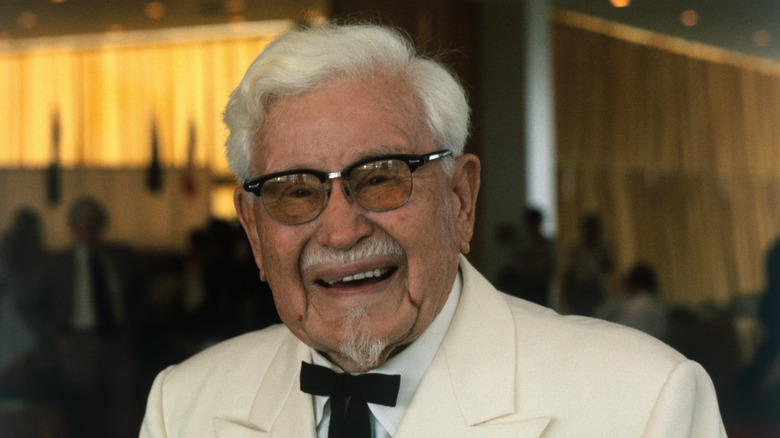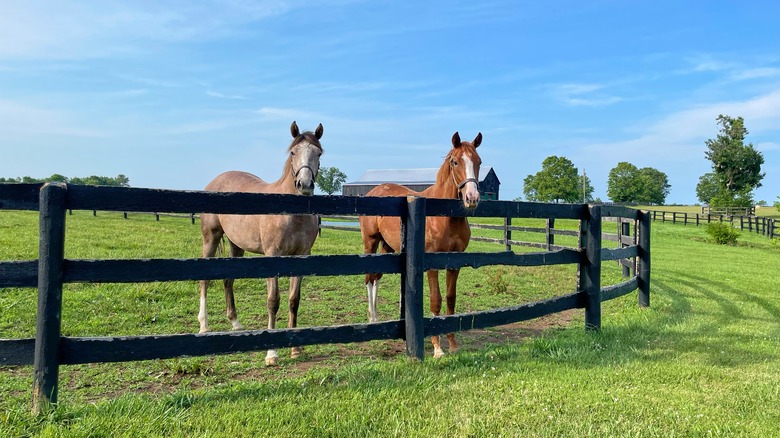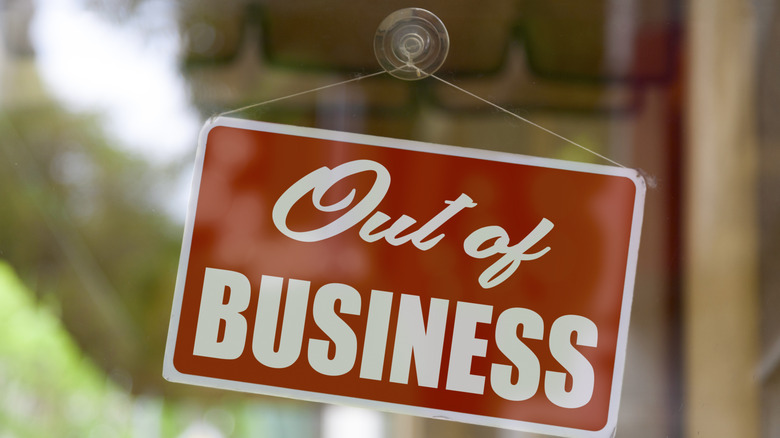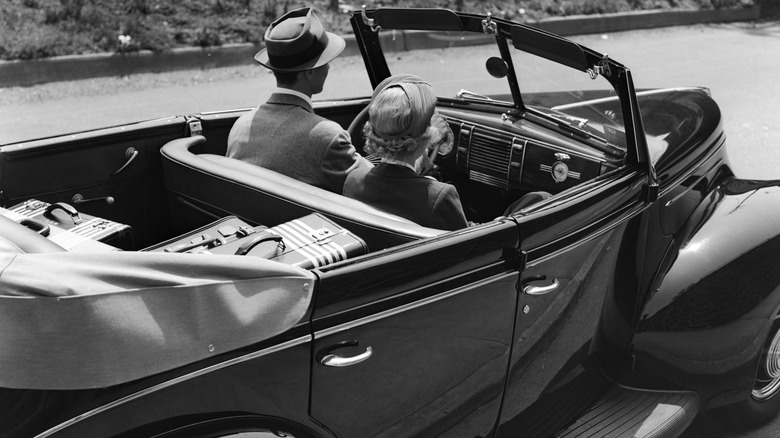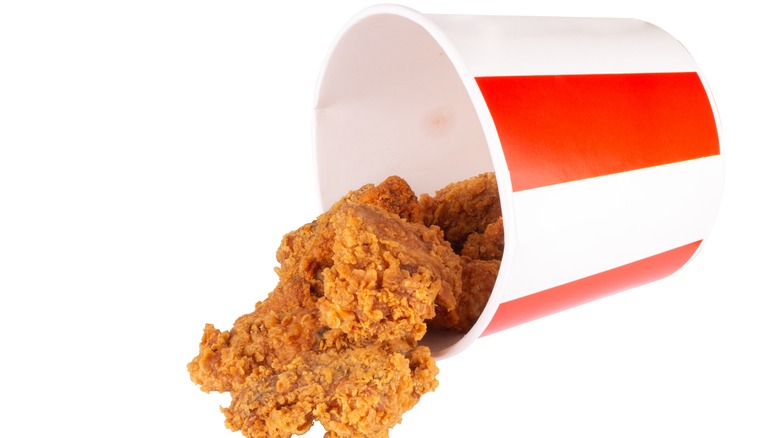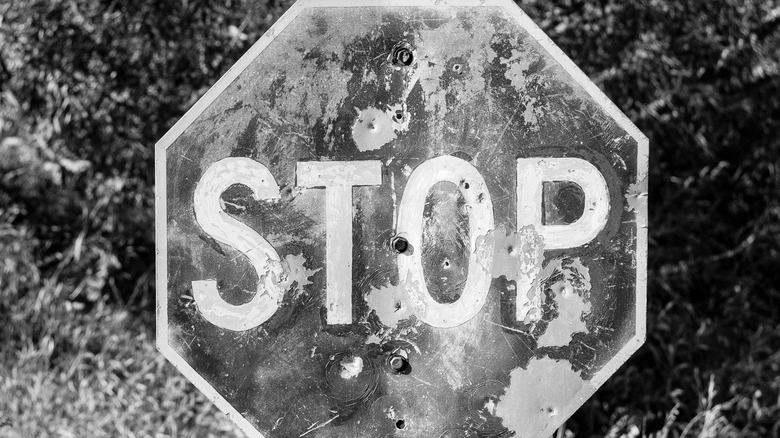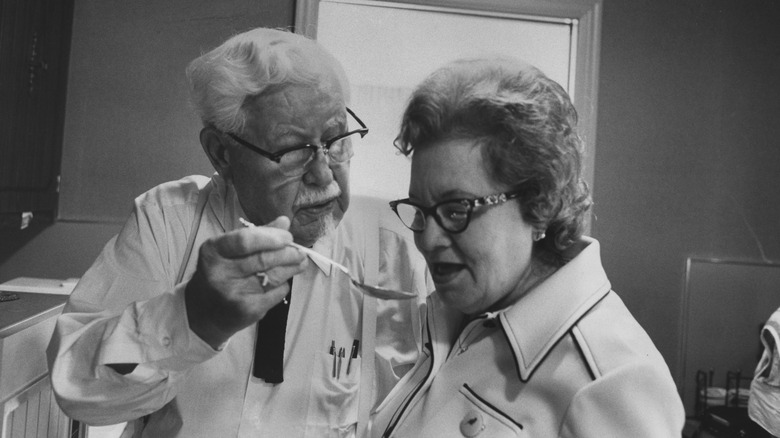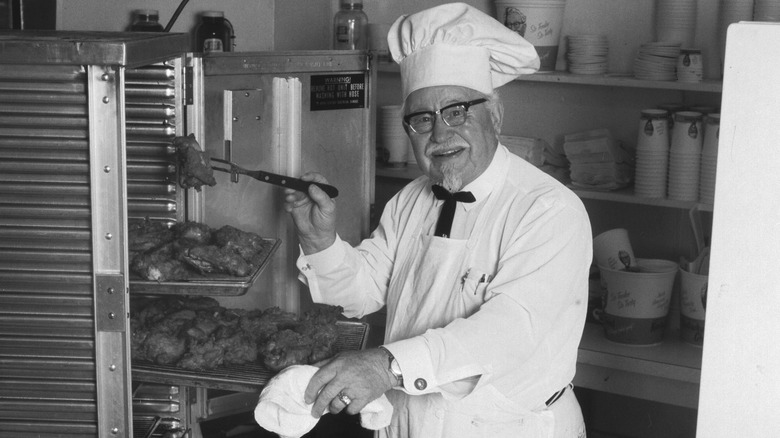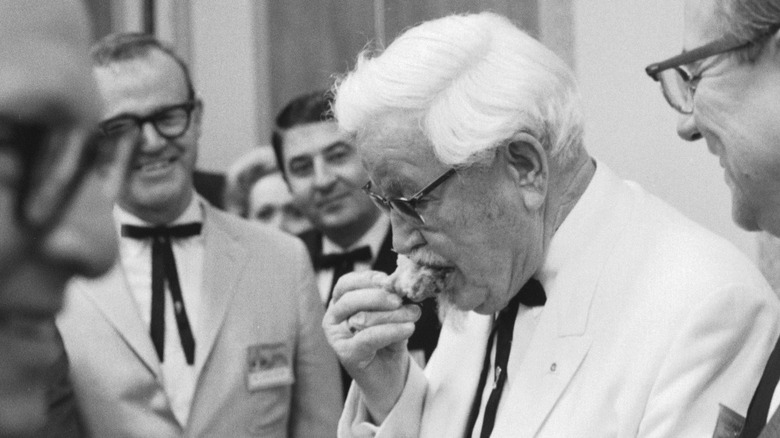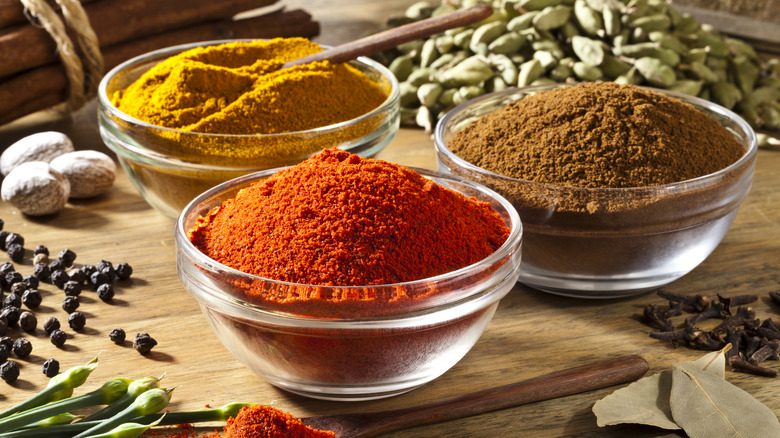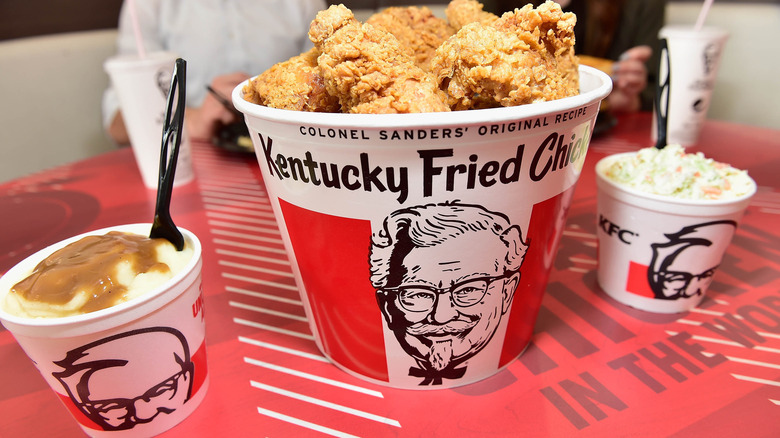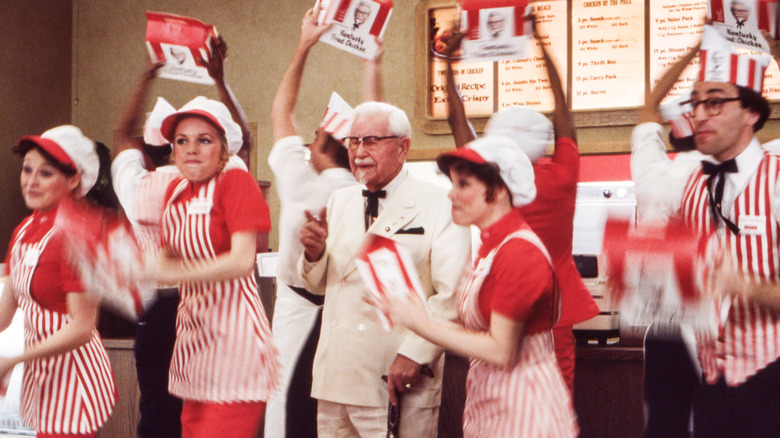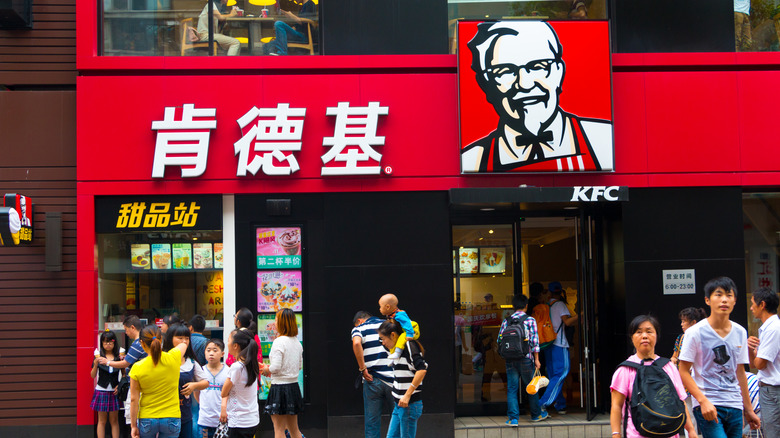The Wild History Of Colonel Sanders
In the world of brand mascots, KFC's Colonel Sanders is one of the most iconic. He's so well-known that just reading his name has probably got you picturing the white-haired, white-besuited old man with his famous smile, Western style bow tie, and browline glasses completing the look. The restaurant he represents is one of the most popular chains in the world. There are more than 25,000 KFC locations in 145 countries around the globe. China has the most KFC restaurants, followed by the United States, Japan, and South Africa. No wonder Colonel Sanders is one of the world's best-known brand mascots. In 2006, he was added to the Madison Avenue Walk of Fame's roster of celebrated mascots, joining the ranks of the Pillsbury Doughboy and McDonald's Grimace.
The Colonel and his restaurants are familiar to many of us, but have you ever wondered about the man behind the familiar image? Unlike many mascots, Harland Sanders was a real person, who led a very unusual, often turbulent existence. Sanders experienced tragedy, triumph, love, loss — and even shot someone. Let's look at some of the wildest moments in Colonel Sanders' fascinating life.
Colonel Sanders is not from Kentucky
Although he's the founder and face of Kentucky Fried Chicken (today, the official branding keeps it at its abbreviation, KFC), Sanders doesn't hail from the Bluegrass State. He was born in 1890 in Henryville, Indiana. When Sanders was 5 years old, his father died and his family began to struggle financially as his mother looked for work. At one point, Sanders had to cook for his brothers and sisters. A few years later, his mother remarried and the family moved ... but not to Kentucky. They stayed in Indiana.
But, while Sanders was born in Indiana, his famous chicken was born in Kentucky. That's where the Colonel eventually settled as an adult and ran a gas station and restaurant where he served meals for travelers — including chicken. Interestingly, Sanders may not even have come up with the name "Kentucky Fried Chicken." Some sources say one of his partners suggested it, while others credit the man who painted the sign for the first franchise. Whatever the case, Sanders was embraced by the state of Kentucky, where he was given the honorary title of Colonel (twice). He also ended his days there, passing away in Louisville, Kentucky, in 1980.
Colonel Sanders' first restaurant went out of business
KFC's crispy and delicious chicken, seasoned with those glorious 11 herbs and spices was sure to be a success, right? At first, this was true. Colonel Sanders served an early version of his famous chicken at a gas station he owned in Kentucky. The chicken became so popular that Sanders was able to open a restaurant — and this was even before KFC's beloved seasoning had reached its final, perfect form. The restaurant did well and was a celebrated local eatery. Even the state governor was a fan. But, when the highway that ran in front of the restaurant was moved customer numbers dwindled and Sanders had to close up shop.
Fortunately, this was not the end of KFC. Sanders knew he was truly talented when it came to chicken. It would just take a few decades for him to ultimately build what became a chicken restaurant empire.
Colonel Sanders roamed the US for years
When we think of an old colonel, we think of a dignified, staid man who might live on some sort of lavish but respectable estate. Unfortunately, this wasn't the case for Sanders, at least not for the majority of his life. Sanders spent much of his adulthood trying his hand at many different jobs, including ferry operator, lawyer, and even midwife. Still, these professions didn't lead him down the path to success. And, when it came to the legal profession, he was a bit too pugilistic; he once got into a fistfight with his own client.
The food industry seemed to suit Sanders better, although it wasn't without his challenges. Between the time his earlier restaurant closed and when he claimed countless Kentucky Fried Chicken franchises, he lived a transitory life, selling his famous chicken recipe around the U.S. Finally, he began to see some success when the first KFC franchise opened in Utah in 1952.
Colonel Sanders invented more than seasoning
KFC's famous seasoning is so well known among fast-food aficionados and fans that "11 herbs and spices" might as well be one of the restaurant's catchphrases. Colonel Sanders created this celebrated, complex flavor combination, but did more for chicken than this alone. To add to his chicken's delicious taste, Sanders came up with a method of preparing and cooking it that allowed it to stay crispier. Sanders didn't just sell his seasoning recipe to franchisees – he also sold them his cooking method.
Colonel Sanders' way of cooking chicken involves dipping chicken pieces in brine and then drying them by tossing them seven times. Afterward, each piece is covered in breadcrumbs by using a take on the breaststroke movement. But, what set Sanders' method apart was the innovative (and, at the time, risky) choice to fry it in purpose-built pressure cookers which is how it's cooked today. The next time you eat KFC, take a moment to appreciate that, in addition to its flavor, the crispy texture you love is a gift from the Colonel himself.
Colonel Sanders took part in a deadly shootout
The smiling Colonel Sanders we all know and love was once an active and willing participant in a shootout. When Sanders ran his gas station, he and a rival were in a constant struggle — not over food or gas, but signage. Sanders and rival Matt Stewart ran their gas stations in Corbin, Kentucky, where it was not uncommon for the population to shoot their guns for recreation, or otherwise.
Sanders had the idea to paint an advertisement for his gas station on a stone wall. The sign allegedly attracted business away from Stewart's gas station, leading him, in a Bugs Bunny-like move, to paint over it. Sanders painted his ad back on top and had a threat-filled argument with Stewart. But, not long after, Stewart started to paint over the sign again.
During a visit from two Shell corporate employees to Sanders' gas station, they headed out to stop Stewart. The ensuing shootout left Robert Gibson, one of the men who'd accompanied Sanders, dead. Sanders' rival Stewart received two bullets, including one in the shoulder from Sanders, and would be given an 18-year prison sentence for Gibson's murder.
Colonel Sanders had a libido - and a mistress
Most of us think of Colonel Sanders as a wholesome, folksy sort of person, with his attention firmly fixed on making and serving top-quality fried chicken. While his dedication to his restaurant and recipe is undeniable, his wholesomeness was far from reality. Those who knew the Colonel well or worked with him closely knew he was quite the ladies' man. New Yorker reporter William Whitworth revealed that at the height of his fame, in 1970, he had many female fans, whom he'd flatter shamelessly (while sometimes criticizing them behind their backs). But, things often went beyond words. For instance, one female Chamber of Commerce employee reportedly had to keep telling the Colonel to keep his hands off her.
Sanders' long-term relationships reflect his womanizing ways. Sanders married Josephine King in 1909. The couple had three children together, but their daughter, Margaret Sanders, told heavy. that her mother found Sanders' physical needs "excessive." Despite their strained marriage, Sanders and King stayed together until 1947, when they finally agreed to divorce. Sanders would find love again with his second wife, Claudia Leddington ... who was his longtime mistress. They'd met when she was a waitress at his first restaurant, and at one point, he'd even hired her as a cleaning lady while he was still married to King.
KFC and Wendy's have a surprising connection
On the surface, KFC and Wendy's have a few things in common. Both are major fast food chains, and both have easily recognizable mascots. But, their connection goes a lot deeper. When Colonel Sanders was traveling around the U.S., selling his chicken recipe to other restaurants, he made a sale to a restaurant called Hobby House, where Dave Thomas was head cook. Thomas became a great admirer of Sanders. A few years later, he was thrilled when his boss asked him to manage four other KFC locations — although this was against the Colonel's will.
According to Thomas, Sanders didn't like that he followed his rules regarding certain chicken preparation steps. Ultimately, though, Sanders must have recognized Thomas' marketing talent as he's credited for inventing the chain's spinning bucket logo and, as legend would have it, convincing Sanders to be the restaurant's mascot and spokesman. Meanwhile, within a few years, Thomas sold his KFC restaurants back to Sanders and used that money to start Wendy's.
Colonel Sanders was actually a real colonel
Some mascots have military honors or important titles, that are just made up (We're looking at you, Cap'n Crunch). But Colonel Sanders was, in fact, a real colonel. Sanders was in the military, serving in Cuba in 1906 and receiving an honorable discharge. That said, his title doesn't come from there. In Sanders' case, "Colonel" was an honorary title he received on behalf of the state of Kentucky. And, he was awarded it twice! The first time was in 1935, due to the popularity of his first restaurant and the quality of its food. Then-Governor Ruby Laffoon was such a huge fan that he thought Sanders more than deserving of this honor.
In 1949, after his restaurant closed and he'd struggled to find success, Sanders was awarded the honorific again. By now, he'd been building his chicken business into a delicious empire. Interestingly, this is when Sanders started to don his soon-to-be-famous white suit and grew out his signature goatee.
KFC's seasoning is (probably) still a secret to this day
Over the years, Sanders continued to develop and refine his chicken cooking technique and seasoning recipe. The 11 herbs and spices recipe was officially perfected in 1940. It's been kept a closely guarded secret ever since. For instance, the blend's ingredients are sourced from two different suppliers. Today, the only physical copy of the recipe is stored in a safe at KFC headquarters in Louisville, Kentucky.
The only time it's been officially copied and shared was in 2019, when a triple-encrypted version was sent to the Pionen bunker for safekeeping. Located in Stockholm, Sweden, and buried 100 feet underground, the bunker houses a data center and can resist the impact of a hydrogen bomb. So, KFC's secret recipe will still be with us even if the rest of society collapses. The question is, would post-apocalyptic humans still keep it a secret? Probably not, since humans today have been trying to crack it for a long time. There have been countless copycat recipes and investigations into just what comprises the 11 herbs and spices. The most convincing of these comes from the Chicago Tribune. In 2016, Joe Ledington, a nephew of Colonel Sanders who worked at KFC, shared an old handwritten recipe with the newspaper. So, the Tribune — among others like the Houston Press – put it to the test and found it to be more or less accurate. But, KFC officially denies its authenticity.
Colonel Sanders had a love-hate relationship with KFC
Colonel Sanders was proud of his chicken, and proud of the empire he eventually built, too. But at the age of 74, he was persuaded to sell it all and take a well-needed rest. The Colonel's retirement wouldn't go as expected, though. The buyers, John Y. Brown, Jr. and Jack Massey, still wanted to keep him on as a spokesman, and Sanders agreed. When they sold KFC to another buyer a few years later, Sanders remained the face of KFC, doing publicity spots, TV appearances, and more.
But this time, things were less than ideal and Sanders became concerned about a decline in KFC's quality. For instance, Sanders reportedly claimed that the gravy tasted like "pure wallpaper paste" (via The New York Times). Worse still, Sanders opened a rival restaurant, leading to a legal dispute between him and KFC. Astonishingly, he continued to be a paid spokesman for KFC through all of this. Sanders was passionate about his creation, so maybe he was just giving KFC some tough love.
Colonel Sanders had some mascot-like qualities
Colonel Harland Sanders was a real person, not a mascot. But, if you think about it, he did have several mascot-like qualities. For one thing, like most mascots, he had a single, distinctive look. In the last decades of his life, Sanders was never seen in public wearing anything but his iconic white suit. And then there's how he remained loyal to his company and appeared in countless TV appearances and ads for KFC, even after having sold the brand and disagreeing with the new owner's way of doing things.
Like all successful mascots, Sanders had an unforgettable, unique style. In the years since he died in 1980, many actors, including Rob Lowe, Reba McEntire, and Mario Lopez, have portrayed him in commercials and other publicity material. As the Colonel, all of them were dressed in a white suit with black details, and even wore a white wig and browline glasses to keep a look similar to the one Sanders sported for so many years. Sanders is first and foremost a genius in fried chicken fast food, but his loyalty and sense of style made him the kind of spokesman and mascot any brand would be lucky to have.
Colonel Sanders has shown up in some surprising places
Many of us think of KFC as quintessential American fast food. But, KFC has restaurants worldwide and started expanding beyond the U.S. surprisingly early. By the 1960's, KFC had already reached the U.K. and Canada. Other countries would soon follow, including China. Today KFC's biggest market, China discovered KFC's deliciousness in 1987, when it was the first American fast food chain to open in the country. China isn't the only place where KFC is popular, though. In Japan, for instance, it's taken on a particular place in popular culture: Eating KFC on Christmas (even for those who don't celebrate the holiday) has become a Japanese tradition.
Not only is the Colonel present in countries around the world; he's also featured in some unusual media. You're probably familiar with actors taking on the Colonel's role in funny ads, but Sanders' image has also popped up in tie-in comic books featuring the Justice League, the soap opera "General Hospital", and even a short Lifetime movie called "A Recipe for Seduction" (Mario Lopez plays the swoon-worthy Colonel). But, possibly the weirdest place Sanders has appeared is in a video game called "I Love You, Colonel Sanders!" Released in 2019, this dating simulator puts the player in a culinary school with a manga-style Colonel whom they have to flirt with (often by talking about chicken).
